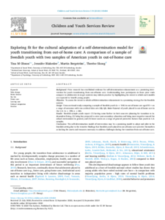Abstract
Background
Prior research has established evidence for self-determination enhancement as a promising intervention for youth transitioning from out-of-home care. Understanding how participants in these prior trials compare to adolescents in target contexts may inform practice by highlighting the extent to which such models are expected to benefit young people.
Objective
To assess the extent to which self-determination enhancement is a promising strategy for the Swedish context.
Design
Cross-sectional study comparing a sample of Swedish youth (n = 104) in out-of-home care aged 15+ on a range of outcomes with two archival data sets (My Life; Better Futures) of youth placed in out-of-home care in the U.S. (n = 295; n = 66).
Results
Swedish sample youth report: (1) having come further in their concrete planning for transition to independent living, (2) being less prepared to enter post-secondary education and being more negative toward the school environment in general, and (3) lower scores on a range of general protective factors than youth in U.S. samples.
Conclusions
The self-determination model of intervention may be a promising model to adapt and pilot in the Swedish setting due to the tentative findings that Swedish youth placed in out-of-home care perceive themselves as lacking the assets and resources necessary to address challenges during the transition from out-of-home care.

